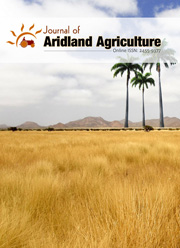In situ nutrient degradation of conventional diets commonly fed to dairy cows in central Myanmar
DOI:
https://doi.org/10.19071/jaa.2015.v1.2659Abstract
The determination of nutrient degradability is very important for the effective use of feeds in ruminant production. Therefore, this experiment was conducted to determine the nutrient degradability and energy protein synchronization of conventional diets commonly fed to dairy cows in the central Myanmar through the in situ method. The conventional diets are Diet-ST (diet from Sin Tel), Diet-MN (diet from Myay Ngu), Diet-TP (diet from Ta Pel) and Diet-AM (diet from Amarapura). The roughage to concentrate ratio of conventional diets ranged from 53:47 to 72:28. The crude protein (CP) content of Diet-TP (17.96%) was significantly higher (p<0.05) than those of other diets with the least CP obtained from Diet-AM (11.46%). Among the conventional diets, wide variation of dry matter (DM) and organic matter (OM) disappearances were observed throughout the incubation times. The highest value (p<0.05) was found in Diet-AM and the lowest (p<0.05) was observed in Diet-ST and Diet-TP. The rapidly degradable fraction “a†and rate of degradation “c†of DM and OM of Diet-AM was significantly higher (p<0.05) than those of other diets. The effective degradability of DM and OM were also highest (p<0.05) in Diet-AM. Generally, the lowest (p<0.05) CP disappearance was observed in Diet-TP. The rapidly degradable fraction “a†of CP was highest (p<0.05) in Diet-ST and the greater (p<0.05) effective degradability was observed for Diet-AM. Moreover, the highest values (p<0.05) of rumen degradable protein (RDP), rumen undegradable protein (UDP) and energy protein synchronization were found in Diet-TP, while the lowest value was observed in Diet-AM. Therefore, it was concluded that all conventional diets could be used as ration for dairy cows; however, the best potential was found in Diet-AM because of its highest effective degradability of nutrients.
Downloads
References
AOAC. Official Methods of Analysis, 15th ed., Association of Official Analytical Chemists, Washington D.C. 1990; p. 69-88.
Czerkawski JW. An introduction to rumen studies. Oxford : Pergamon Press. 1986.
Elseed FAMA. Effect of supplemental protein feeding frequency on ruminal characteristics and microbial N production in sheep fed treated rice straw. Small Rumin. Res. 2005; 57: 11-17.
Goering KH, Van Soest PJ. Forage fibre Analysis, Agricultural Hand book. 379. USDA, Washinton D.C. 1970; p: 8-12.
Harrison DG, Beever DE, Thompson DJ, Osbourn DF. Manipulation of rumen fermentation in sheep by increasing the rate of flow of water from the rumen. J. Agric. Sci. 1975; 85: 93.
Hemsley JA. Effect of high intake of sodium chloride on the utilization of a protein concentrate by sheep. Austr. J. Agric. Res .1975; 26: 709.
Kaswari T, Lebzien P, Flachowsky G. Studies on the relationship between the synchronization index and the microbial protein synthesis in the rumen of dairy cows. Anim. Feed Sci. Technol. 2006; 139: 1-22.
Lardy GP, Ulmer DN, Anderson VL, Caton JS. Effect of increasing level of supplemental barley on forage intake, digestibility, and ruminal fermentation in steers fed medium quality grass hay. J. Anim. Sci. 2004; 82: 3662-3668.
Lindberg JE, Kaspersson A, Ciszuk P. Studies on pH, number of protozoa and microbial ATP concentrations in rumen-incubated nylon bags with different pore size. J. Agri. Sci. 1984; 102: 501.
Maghsoud B, Akbar T, Hossein J, Ali MG. Evaluation of some by-Products using In situ and In vitro gas production techniques. Ameri. J. Anim. Vet. Sci. 2008; 3 (1): 7-12.
Mehrez AZ, Orskov ER. A study of artificial fibre bag technique for determining the digestibility of feeds in the rumen. J. Agric. Sci. 1977; 88: 645-650.
Michalet-Doreau B, Cerneau P. Influence of foodstuff particle size on in situ degradation of nitrogen in the rumen. Anim. Feed Sci. Technol. 1991; 35: 69-81.
Nocek JE. In situ and other methods to estimate ruminal protein and energy digestibilty: A Review. J. Dairy Sci. 1988; 71: 2051-2069.
Nocek JE, Russell JB. Protein and energy as an integrated system: relationship of ruminal protein and carbohydrate availability to microbial synthesis and milk production. J. Dairy Sci. 1988; 71: 1070-2107.
NRC. National Research Council. Nutrient requirement of dairy cattle. 7th Rev. Edn. Natl. Acad. Sci., Washington, DC. 2001.
Ørskov ER, McDonald LM. Estimation of protein degradability in the rumen from incubation measurement weighted according to rate of passage. J. Agri. Sci. 1979; 92: 499-503.
Riasi M, Danesh-Mesgaran M, Stern D, Ruiz-Morenob MJ. Chemical composition, in situ ruminal degradability and post-ruminal disappearance of dry matter and crude protein from the halophytic plants Kochia scoparia, Atriplex dimorphostegia, Suaeda arcuata and Gamanthus gamacarpus. Anim. Feed Sci. Technol. 2008; 141: 209-219
Sinclair LA, Garnsworthy PC, Beardsworth P, Freeman P, Buttery PJ. The use of cytosine as a marker to estimate microbial protein synthesis in the rumen. Anim. Prod. 1991; 52: 592.
SPSS. Statistical Package for the Social Sciences. Version 16.0. SPSS Inc. United State of America. www.spss.com. 2007.
Steel RG, Torrie JH. Principles and procedures of statistics. A biometrical approach 2nd ed., Mc Graw-Hill Book Company, New York. 1980.
Tatli-Seven P, Cerci IH. Relationships between nutrient composition and feed digestibility determined with enzyme and nylon bag (in situ) Techniques in Feed Sources. Bulga. J. Vet. Med. 2006. 9 (2): 107-113.
Warner ACI. Rate of passage of digesta through gut of mammals and birds. Nutr. Abst. Rev. 1981; 51: 789.





 .
.